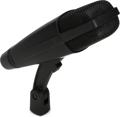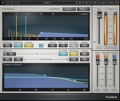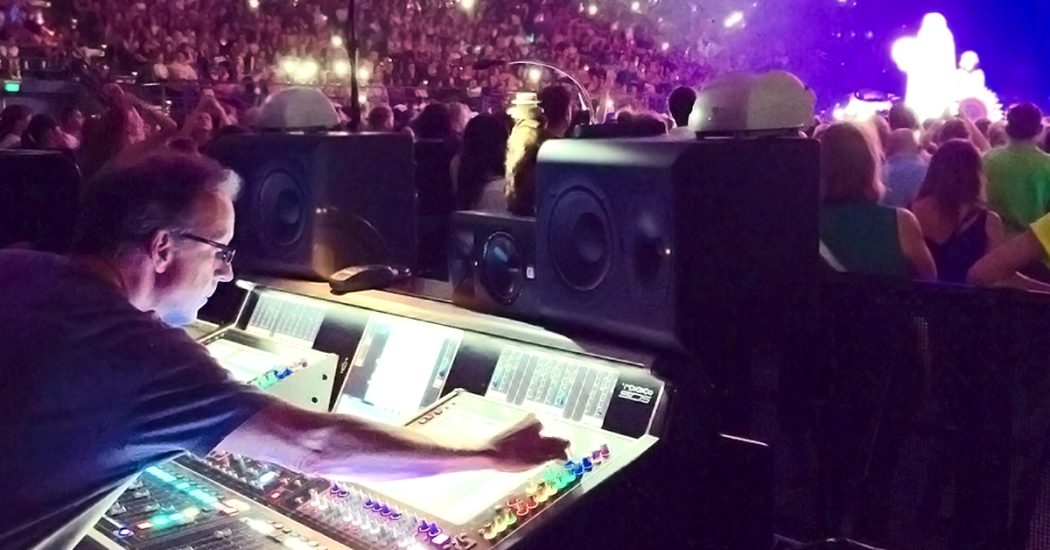
Nine Inch Nails. David Bowie. Katy Perry. ZZ Top. David Byrne. St. Vincent. Front of house engineer Pete Keppler‘s client roster is loaded with some of the biggest, most demanding names in the music business. Pete‘s ability to bring the best out in any performance, anywhere, keeps him jet-setting to venues around the world. In short, when it comes to front of house sound, Pete has seen it all, heard it all, and done it all.
Recently, Sweetwater caught Pete between gigs and asked him to share a little of his front of house magic with us. We swear, we got smarter just sitting in the same room with him. Here‘s how it all went down:
From Nine Inch Nails to David Bowie to Katy Perry, you’ve spanned many genres in your FOH career. What are the universal “truths” of live sound that span all genres?
Pete Keppler: Air… The ultimate truth. You need to push sound through it for every show, and it’s not as easy as you might think. Conditions change a lot (especially outdoors), and the higher the frequencies, the more they’ll be affected. On the other hand, low-frequency (sub) management is an art. If you don’t know how to do it, find someone who does. Live and learn!
The artists I’ve been fortunate enough to work with are all basically true live acts: there may be backing tracks (playback) in some cases, but the end result is primarily human-derived. There will be many variables from night to night, and changes in the feel and the groove of the same song will change from show to show. Mistakes of all kinds will inevitably happen. Embrace it — one doesn’t get that experience listening to recorded music!
One universal truth (for me) is that I mix every artist as a live entity. I’ve never mixed any artist as if it were their record. There are certainly times when perhaps an effect or sound from an album needs to be present in the mix, but from the moment I first start working with an artist, I try and find the strengths in them and/or the band, and focus on bringing those elements out. It may be quite a different mix than the record, but then again, it may be a whole different band than played on the record in the first place.
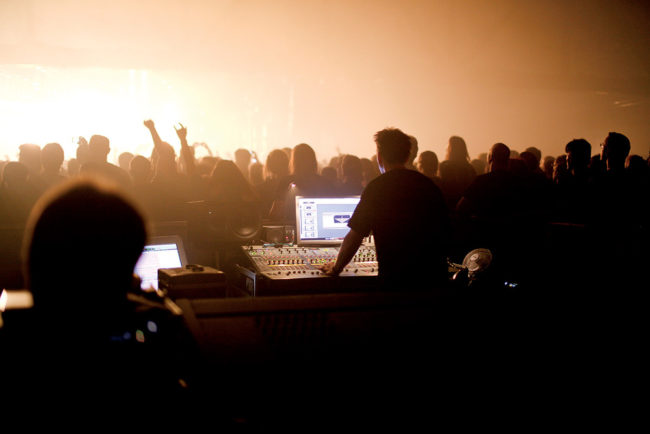
What have been the most challenging tours to run sound for? What made them challenging?
Probably Nine Inch Nails: the “Lights in the Sky” Tour in 2008. Aside from the usually stepped-up level of intensity that NIN was for me (T.R.’s [Trent Reznor] not what you’d call your “average employer”), this tour had two entirely different sets of backline in one show. The regular set included drums, bass, many keyboards and synths, a playback setup, guitars and vocals. Then, in the middle of the show, the stage would swap out to an “acoustic” set of backline: a drum kit made of garbage cans, water bottles, pots and pans, and various sheets of metal, an upright bass, a banjo, a celeste, acoustic guitar, an 8-foot long marimba, and several other odds and ends. They’d play about a 40-minute set on that and then switch stages back to the electric set to finish the show.
Katy’s show had its challenges too, but they were more in the quality of audio from the limitations of some of the sources. We were required to use primarily in-the-box sounds (virtual guitar amps, software-based keys, samples and drum triggers, etc.). Even though they were being played by real people, making those sounds bigger and more “human” posed its challenges.
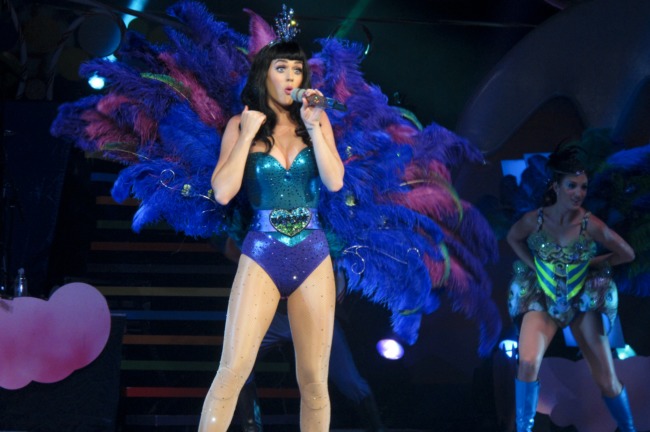
What are the most common mistakes you hear people make when running sound?
1. Using overall volume to compensate for the ability to really balance a mix: With today’s sound systems it’s very easy to push the level up and up. While loudness can certainly leave an impression, it also leaves the listener (and engineer) fatigued, and quite possibly with some hearing damage.
2. Overuse of plug-ins: Going to the source of the sound is the best way to make a correction for poor audio quality. I find myself using fewer and fewer plug-ins these days, and instead choosing a different mic or mic placement. With very few exceptions, if I’m EQing more than 3–4dB on any input (or the whole sound system), I will investigate other approaches. Obviously, if you’re thrown into mixing a festival with a band you’ve never heard and no sound check, you do what you have to, to achieve the desired result! Also, for a monitor engineer, many plug-ins add latency, which often does not play well, especially with in-ears.
3. Overuse of compression and limiting: Even if the volume of an overall show is kept at a reasonable level, if the inputs are all being smashed down with compression, the fatigue factor will again come into play. I think the biggest thing I’ve learned over the years is when to use compression, what kind of compression and how much to use. It’s a live performance… Let it breathe a little!
What are the most important things an artist or band can do to improve their live sound?
As I mentioned already, if you need to try and improve the quality of your audio, start as close to the source as you possibly can. For example, if you or the engineer are unhappy with the sound of their guitar rig or drum kit, give the engineer some time to experiment and find what works best. Ask your gear supplier if you can try out some different mics, etc.
One of the more recent developments in live sound is the ability for almost anyone to use in-ear monitoring systems. While these can benefit both the FOH and Monitor engineers by reducing stage volumes and the risk of feedback, I’ve noticed a downside: many performers using in-ears tend to keep themselves quite loud in their own mix, and turn down the rest of the musicians. In the isolated world of in-ears, the performer may lose perspective on how they actually “sit” in the mix. Often this presents the FOH engineer with disproportionate levels, and he or she will have a lot more work on their hands. In the case of vocalists with in-ears, I’ve watched performers ask for more and more of their own voice, only to start backing away from the mic, or singing more quietly than they normally would.
What are the current trends in gear that excite you?
Plug-in modeling has come a long way, and there are some companies doing really extensive work to bring some amazing replicas of vintage and cool-sounding gear, as well as expanding out and coming up with some software that manipulates sound in ways we were never able to before.
There’s also some cool technology happening with sound systems regarding the ability to electronically point and direct sound, and also have excellent continuity in the frequency response of the system from the front rows to the furthest reaches of your venue.
I’ve been able to play around with some virtual consoles (basically a touchscreen with all the faders and control that a hardware console has) and I’m pretty impressed with what’s been done (Waves LV1 in particular). Far more compact and lightweight to carry your console in a large briefcase than a big ol’ roadcase!
What piece (or pieces) of gear had the biggest impact on your life?
Honestly, the turntable I bought last year has probably affected the largest change in my thinking in recent years. I hadn’t owned one since 1987. Before that, probably the two cassette decks I used to ping-pong “multi-track” recordings together. Also my first SM57, when I could finally afford one.
If you could give advice to an aspiring engineer, what would it be?
Say “yes” to practically any gig, short of cleaning the tour-bus toilet. Any experience you can have early in audio will be educational, no matter how boring it may seem. Music, corporate talking heads, TV and broadcast, etc. — assisting in any way, shape, or form to audio-related endeavors. And if you really want to be a badass front of house engineer, do monitors for a couple years.
What piece of advice forever changed your approach?
If the artist has a question, make sure you have an answer, even if it’s “I don’t know, but I’ll find out.” Don’t waffle. And don’t undercharge for your services — you won’t be taken seriously.
You’re currently running FOH for Bonnie Raitt. What’s her setup like?
Very straight-ahead. Bass, drums, two guitars, and keys (B3 and one synth). Everybody sings. Bonnie and George’s guitar cabs are isolated, DPA and AKG mics on the kit, with AEA ribbons on the overheads and George’s stereo guitar, and a Sennheiser 421 on Bonnie’s electric. She sings through Telefunken M80s, and the rest of the guys are on Audix OM5s. Bonnie’s acoustics are stereo pickups run through a preamp. The monitor engineer and I both use DiGiCo SD-Ten consoles running on a fiber-optic loop (no mic splitter). We normally tour with a D&B J-system, and everyone but the bass player is on in-ears.
What are some of your “go-to” plug-ins when running FOH?
As I mentioned previously, I use far fewer plug-ins than I used to. However, if you were to ask me what I couldn’t live without these days, Waves C6 would be at the top of the list. It’s an audio Swiss Army Knife. Waves TrueVerb… Best software room simulator/short reverb. Soundtoys makes some really cool stuff… Decapitator and EchoBoy, Devil-Loc Deluxe. The UAD stuff is really cool, too… Some of the most accurate compressor-modeling out there, and their EMT Plate reverb is amazingly realistic. One final plug: McDSP FilterBank: it’s a somewhat lesser-known piece of software, but a really nice-sounding EQ.


